Phase out problem plants with these Texas-tough trend setters.
Many things in life seem to repeat a cycle of going in and out of style. From fashion trends to art to hairstyles (the mullet is back), one aspect of suburban life that seems to be a bit slower to change is garden style.
So, let’s talk about some ways to update your style with timeless plants that are sensible and beautiful.
Trees
PHASE OUT
Vitex, chaste tree (Vitex agnus–castus)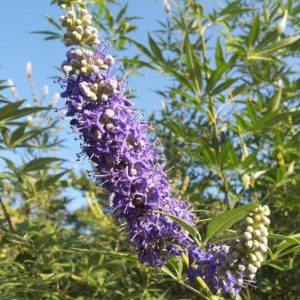
Native to the Mediterranean, vitex is a showy tree that has found its way into many yards across Texas. The problem with Vitex is that it is very invasive. Flashy spikes of blue flowers produce thousands of seeds that invade natural spaces and reproduce quickly, crowding out other native species.
REPLACE WITH
Desert willow (Chilopsis linearis)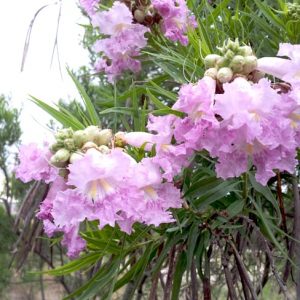
Unrelated to the willow (which uses lots of water) the desert willow can be found in arid washes in south central Texas. It prefers good drainage and in fact it doesn’t like to be overwatered. A smaller tree with long, slender willow-like leaves and a twisted trunk, it can fit in most suburban yards. Striking bell-shaped flowers vary in color from white to purplish pink. These large aromatic blooms are consistent in the spring but will also appear sporadically after rains through October.
Large shrubs
PHASE OUT
Crape myrtle (Lagerstroemia sp.)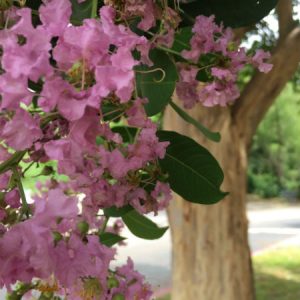
Wait a second. Isn’t crape myrtle a tree? Yes! But it’s also considered the state shrub of Texas. Many large crape myrtles are repeatedly over-pruned to force them into a shrub-like size. I think Texas has plenty of tough plants that would make better shrubs. If you’re from the South, you’re undoubtedly familiar with crape myrtle’s smooth bark and showy summer blooms. Although for decades it has been a staple in landscapes, in recent years many have experienced problems with pests like powdery mildew and sooty mold. Scorching summers are leaving many around town looking terrible, with the top half dead and resprouting midway up the branches.
REPLACE WITH
Goldenball lead tree (Leucaena retusa)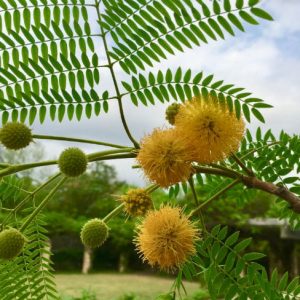
The goldenball lead tree looks almost tropical with ferny, bipinnate leaves and slender spreading limbs, but it’s found in the most arid and rocky conditions of western and central Texas. Sweet smelling golden flowers shaped like little puff balls (think “Horton Hears a Who”) show up in spring and through fall after rains. It doesn’t get too tall or heavy but will spread wide over time, especially in well-drained thin soils of the Texas Hill Country. Not ideal for a shade tree, it allows plenty of light for a garden underneath its graceful branches.
Small shrubs
PHASE OUT
Nandina, heavenly bamboo (Nandina domestica)
Nandina or heavenly bamboo is neither bamboo nor heavenly. This invasive exotic plant has a devilish side. Not only does it outcompete our native understory plants, but it actually kills! Many plants are poisonous but what sets the nandina apart is that our songbirds gorge on the red berries that contain a cyanide compound that’s fatal to them.
REPLACE WITH
Agarita (Mahonia trifoliata)
Agarita is a hill country specialist. It’s a striking shrub that has been used by native peoples throughout Texas. Spiny glaucus leaves on twisted branches which are usually five feet tall and a bit wider. Hiking the trails in San Antonio in late winter I know spring is here by their perfume filling the crisp air. Their pretty golden flowers give way to delicious magenta berries in early summer. Try some before the birds get to them first. Lay a sheet around the base like the skirt of a Christmas tree and give it a shake.
Perennial flowers
PHASE OUT
Tropical milkweed, Mexican butterfly weed (Asclepias currasavica)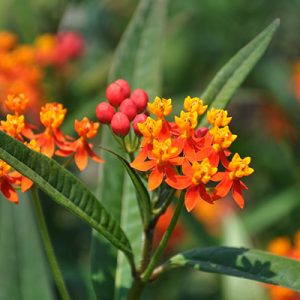
The plant genus Asclepias is a host plant for monarch butterflies. Many folks, wishing to help the monarch, drove the demand for this invasive milkweed species and it has become popular landscape plant. Tropical milkweed is fast growing, easy to propagate and brightly colored. Alas, research has shown that this plant disrupts the monarch butterfly’s complex natural migration and life cycle. It also harbors a parasite that can kill the iconic monarch. Luckily there are plenty others to choose.
REPLACE WITH
Texas milkweed (Asclepias texana)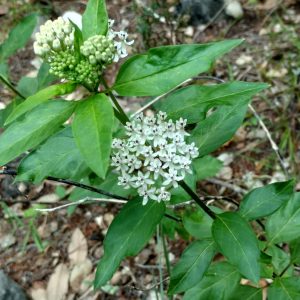
Texas milkweed is from, you guessed it, central Texas. One of the more versatile native milkweeds it will bloom in shade or sun. Cheerful snow-white flower clusters attract a multitude of pollinators and, of course, serve as a safe host plant for monarch and queen butterflies.
Annual flowers
What about annual color? If spending money is your hobby, then annuals are a good way to do it. But there are plenty of perennial plants that can fill a flower bed with color without as much work, money or water.
|
PHASE OUT |
REPLACE WITH |
|
Begonias |
Heartleaf skullcap, cedar sage |
| Impatiens | Lyre leaf sage, scarlet sage, golden groundsel |
| Vinca | Blackfoot daisy, purple skullcap |
| Marigold | Four nerve daisy, zexmenia |
| Zinnia | Gayfeather, cut-leaf daisy |
Ornamental Grass
PHASE OUT
Maidenhair grass (Miscanthus sinensis ‘Gracillimus’)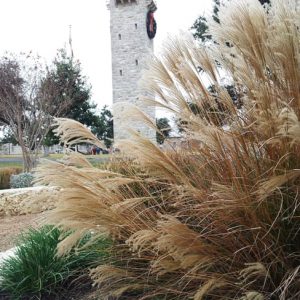
Maidenhair grass is a common space filler in landscape designs. Is it attractive? Not really. But Miscanthus sinensis ‘Gracillimus’, also known as maiden grass or Chinese silvergrass, is listed as an invasive species. It’ been known to displace native species and pose an increased wildfire risk. The truth is invasive species don’t become invasive overnight. Why use exotic plants that haven’t adapted to existing flora, fauna and natural processes of a given ecosystem? Especially when there are so many beautiful options that are already a part of Texas.
REPLACE WITH
Big muhly (Muhlenbergia lindheimeri)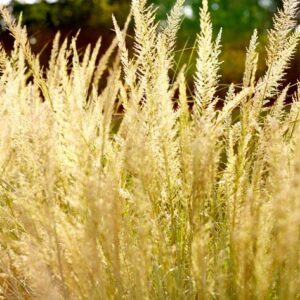
Ornamental grasses come in a wide variety, and like this Lindheimer’s muhly, are generally drought tolerant, grow in poor soils, and add color, texture and interest to any fall garden.
Big muhly is, well, big! This evergreen bunch grass does more than fill a space in a landscape — it thrills a landscape with long, narrow blue-green leaves and inflorescences that extend dramatically above the plant on graceful plumes of silvery gold. It can also serve as a type of screen or hedge when strategically planted.
Ok, so these trendy plants might not all be new kids on the block, but what is going viral is the idea that what we plant has a huge impact on everything outside the proverbial white picket fence. In fact, these plants have been here before we were. For eons they have adapted and kept up with the changing trends of weather, geology and biology.


